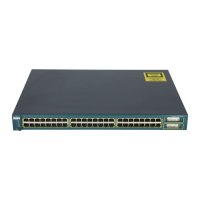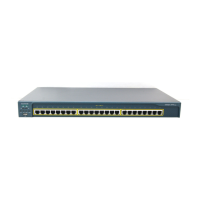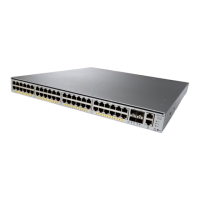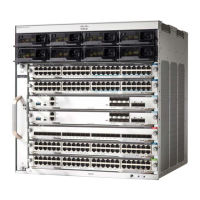7-17
Catalyst 2950 and Catalyst 2955 Switch Software Configuration Guide
78-11380-10
Chapter 7 Clustering Switches
Planning a Switch Cluster
• If the command switch is a Catalyst 2950 running Cisco IOS Release 12.1(9)EA1 or later or a
Catalyst 2955, candidate and member switches can belong to different management VLANs.
However, they must connect to the command switch through their management VLAN.
• Catalyst 2950 standby command switches running Cisco IOS Release 12.1(9)EA1 or later and
Catalyst 2955 standby command switches can connect to candidate and member switches in VLANs
different from their management VLANs.
If you add a new, out-of-box switch to a cluster and the cluster is using a management VLAN other than
the default VLAN 1, the command switch automatically senses that the new switch has a different
management VLAN and has not been configured. The command switch issues commands to change the
management VLAN of the new switch to the one the cluster is using. This automatic VLAN change only
occurs for new, out-of-box switches that do not have a config.text file and that have no changes to the
running configuration. For more information, see the “Discovery of Newly Installed Switches” section
on page 7-10.
You can change the management VLAN of a member switch (not the command switch). However, the
command switch will not be able to communicate with it. In this case, you will need to manage the switch
as a standalone switch.
You can globally change the management VLAN for the cluster as long as each member switch has either
a trunk connection or a connection to the new command-switch management VLAN. From the command
switch, use the cluster management vlan global configuration command to change the cluster
management VLAN to a different management VLAN.
Caution You can change the management VLAN through a console connection without interrupting the console
connection. However, changing the management VLAN ends your CMS session. Restart your CMS
session by entering the new IP address in the browser Location field (Netscape Communicator) or
Address field (Microsoft Internet Explorer), as described in the “HTTP Access to CMS” section on
page 4-9.
LRE Profiles
In Cisco IOS Release 12.1(14)EA1 or later, the Catalyst 2950 LRE switches do not support public
profiles.
In software releases earlier than Cisco IOS Release 12.1(14)EA1, a configuration conflict occurs if a
switch cluster has LRE switches that use both private and public profiles. If one LRE switch in a cluster
is assigned a public profile, all the LRE switches in that cluster must have that same public profile.
Before you add an LRE switch to a cluster, make sure that you assign it the same public profile used by
other LRE switches in the cluster.
A cluster can have a mix of LRE switches that use different private profiles.
Availability of Switch-Specific Features in Switch Clusters
The menu bar on the command switch displays all options available from the switch cluster. Therefore,
features specific to a member switch are available from the command-switch menu bar. For example,
Device > LRE Profile appears in the command-switch menu bar when at least one
Catalyst 2900 LRE XL or Catalyst 2950 LRE switch is in the cluster.
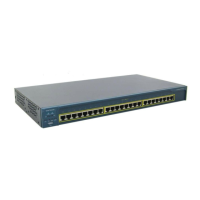
